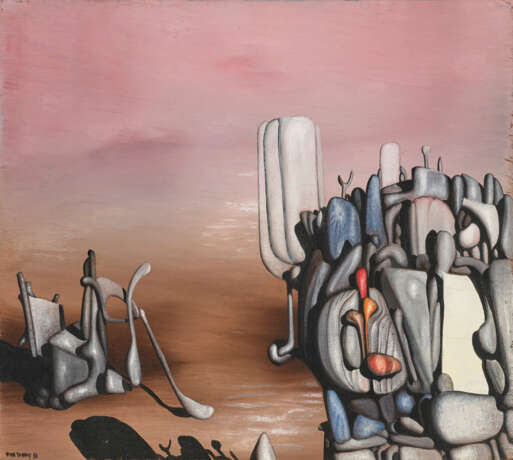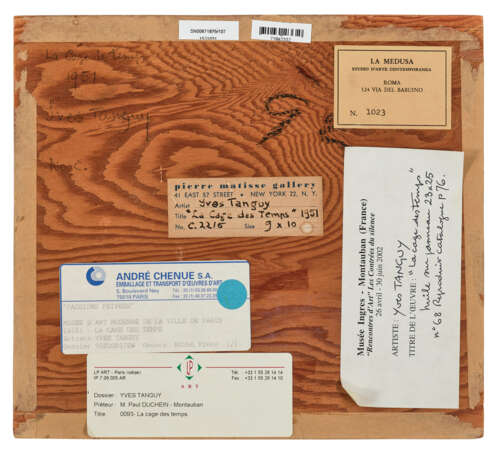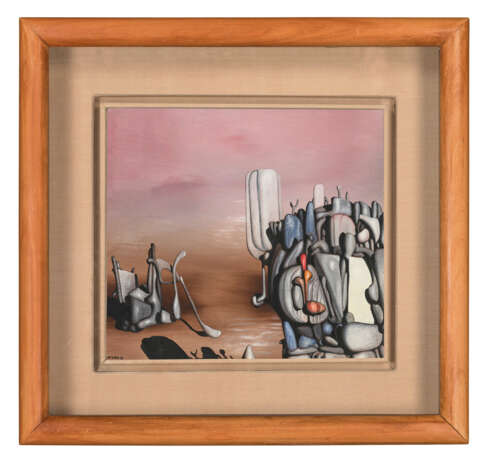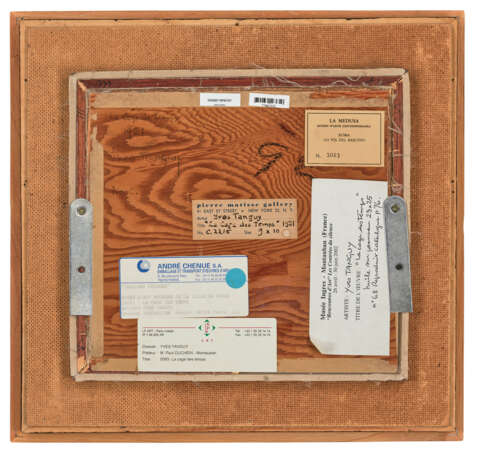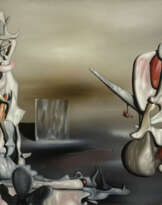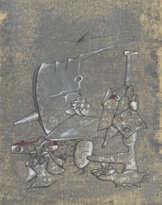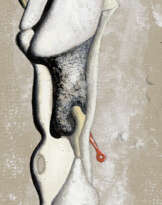ID 1302221
Lot 53 | Yves Tanguy (1900-1955)
Estimate value
€ 180 000 – 250 000
La Cage des Temps
signé et daté ‘YVES TANGUY 51’ (en bas à gauche)
huile sur panneau
22.7 x 25.2 cm.
Peint en 1951
signed and dated 'YVES TANGUY 51' (lower left)
oil on panel
8 7/8 x 10 in.
Painted in 1951
Provenance
Pierre Matisse Gallery, New York (acquis auprès de l'artiste avant mars 1953).
Lieutenant Bayard Cutting Auchincloss, Oklahoma City (acquis auprès de celle-ci en 1954).
Vente, Parke-Bernet Galleries, Inc., New York, 12 mai 1965, lot 92.
Galerie La Medusa, Rome.
Galerie Jan Krugier, Genève.
Acquis auprès de celle-ci en décembre 1973.
Literature
P. Matisse, Yves Tanguy, Un Receuil de ses œuvres, New York, 1963, p. 184, no. 430 (illustré).
Exhibited
Paris, Musée d’Art moderne de la Ville de Paris, Passions privées, Collections particulières d’art moderne et contemporain en France, décembre 1995-mars 1996, p. 222, no. A18.12 (illustré, p. 223).
Montauban, Musée Ingres, Du Ciel à la Terre, juin-octobre 1997, p. 117, no. 113 (illustré en couleurs).
Montauban, Musée Ingres, Les contrées du silence, avril-juin 2002, p. 76, no. 68 (illustré en couleurs).
Quimper, Musée des Beaux-Arts et Barcelone, Museu Nacional d'Art de Catalunya, Yves Tanguy, L’univers surréaliste, juin 2007-janvier 2008, p. 206, no. 215 (illustré en couleurs).
Further Details
Yves Tanguy, peintre français et figure emblématique du mouvement surréaliste, est surtout connu pour ses paysages oniriques peuplés de formes biomorphiques étranges et évocatrices. Dans les années 1950, son travail atteint une maturité exceptionnelle, marquée par une complexité accrue et une maîtrise technique indéniable. Les tableaux de cette période sont salués pour leur originalité et leur capacité à susciter l’imagination.
Les œuvres de cette décennie se distinguent par leur atmosphère énigmatique et leur capacité à transporter le spectateur dans un univers parallèle. La Cage des Temps peinte par l’artiste en 1951 en reprend les caractéristiques essentielles. Elle dépeint une large étendue désertique infinie dans laquelle des objets abstraits flottent ou se dressent comme des vestiges d'un autre monde. Les couleurs douces et éthérées dans des tonalités de rose, de beige et de gris créent une ambiance à la fois sereine et mystérieuse, typique des années 1950.
Au cours de cette période, Tanguy utilise des formes organiques qui semblent à la fois familières et inconnues. Cette fascination pour les formes étranges remonte à son enfance passée en Bretagne, lorsqu’il « visionnait au travers d'un verre fumé des présences insolites des êtres larvaires » (G.-M. Tanguy, ‘Yves Tanguy’, in France Archives, 2000https://francearchives.gouv.fr/fr/pages_histoire/38900)
Ces formes, souvent comparées à des concrétions minérales ou à des créatures marines, rappelant sa passion pour la géologie et le monde marin, émergent de la toile avec une précision presque sculpturale. L’artiste joue avec les ombres et la lumière pour donner à ces entités une sensation de volume et de présence tangible, malgré leur nature irréelle.
Les compositions de Tanguy des années 1950 révèlent également une profondeur symbolique psychologique. L’artiste explore des thèmes comme l'inconscient, le rêve et l’infini, invitant le spectateur à une introspection profonde. Chaque toile est une fenêtre ouverte sur un monde intérieur, une invitation à la contemplation et à la méditation. La Cage des Temps résonne comme une réflexion silencieuse sur l’éternité et le passage du temps. Ce titre semble particulièrement bien choisi par celui qu’Eluard surnommait le « guide du temps des druides du gui ».
Ainsi, les années 1950 constituent une période clé dans la carrière d’Yves Tanguy, où son art atteint une synthèse parfaite entre technique et imagination dont témoigne la présente toile. Les tableaux de cette période influenceront non seulement ses contemporains surréalistes tels Roberto Matta et Wolfgang Paalen, mais aussi de nombreux artistes des générations suivantes.
Yves Tanguy, a French painter and an iconic figure of the Surrealist movement, is best known for his dreamlike landscapes populated with strange and evocative biomorphic forms. In the 1950s, his work reached an exceptional maturity, marked by increased complexity and undeniable technical mastery. The paintings from this period are celebrated for their originality and ability to spark the imagination.
The works from this decade are distinguished by their enigmatic atmosphere and their capacity to transport the viewer into a parallel universe. La Cage des Temps, painted by the artist in 1951, encapsulates these essential characteristics. It depicts a vast, infinite desert expanse in which abstract objects float or stand like remnants of another world. The soft, ethereal colors in shades of pink, beige, and gray create an ambiance that is both serene and mysterious, typical of the 1950s.
During this period, Tanguy used organic forms that seem both familiar and unknown. This fascination with strange shapes dates back to his childhood in Brittany, where he "envisioned through a smoked glass the unusual presences of larval beings" (G.-M. Tanguy, ‘Yves Tanguy,’ in France Archives, 2000). These forms, often compared to mineral concretions or marine creatures, reflecting his passion for geology and the marine world, emerge from the canvas with an almost sculptural precision. The artist plays with shadows and light to give these entities a sense of volume and tangible presence, despite their unreal nature.
Tanguy's compositions from the 1950s also reveal a psychological symbolic depth. The artist explores themes such as the unconscious, dreams, and infinity, inviting the viewer to deep introspection. Each canvas is an open window to an inner world, an invitation to contemplation and meditation. La Cage des Temps resonates as a silent reflection on eternity and the passage of time. This title seems particularly well-chosen by someone whom Eluard dubbed "the guide of the time of the druids mistletoe."
Thus, the 1950s constitute a key period in Yves Tanguy's career, where his art achieves a perfect synthesis between technique and imagination, as evidenced by the present canvas. The paintings from this period would influence not only his Surrealist contemporaries like Roberto Matta and Wolfgang Paalen but also many artists of subsequent generations.
| Artist: | Yves Tanguy (1900 - 1955) |
|---|---|
| Applied technique: | Oil on panel |
| Auction house category: | Paintings, Watercolors, Drawings, Paintings |
| Artist: | Yves Tanguy (1900 - 1955) |
|---|---|
| Applied technique: | Oil on panel |
| Auction house category: | Paintings, Watercolors, Drawings, Paintings |
| Address of auction |
CHRISTIE'S 8 King Street, St. James's SW1Y 6QT London United Kingdom | |
|---|---|---|
| Preview |
| |
| Phone | +44 (0)20 7839 9060 | |
| Buyer Premium | see on Website | |
| Conditions of purchase | Conditions of purchase |
